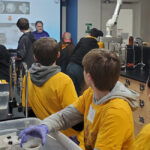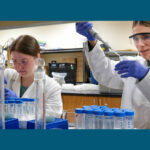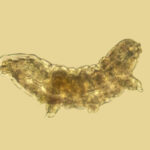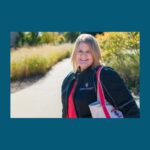UW-Madison
-
Why do birds make so many different sounds? A new UW–Madison study gets at the underlying factors

March 27, 2025
Birds make sounds to communicate, whether to find a potential mate, ward off predators, or just sing for pleasure. But the conditions that contribute to the immense diversity of the sounds they make are not well understood. Researchers at the University of Wisconsin–Madison have conducted the first-ever global study of the factors that influence bird […]
-
A novel approach to PFAS removal and awareness efforts

March 12, 2025
When it comes to PFAS research and education, Seyed Javad Amirfakhri is professionally and personally invested. Amirfakhri is an Assistant Professor of Paper science and Chemical Engineering at UW-Stevens Point who is conducting innovative PFAS removal research. He also has five children and wants to make sure drinking water is safe for them and others. […]
-
Research collaboration tackles phosphorus pollution and educates youth

March 4, 2025
If you’ve seen blue-green algae on local lakes and rivers, you’ve seen the effects of agricultural runoff — particularly phosphorus pollution. This nutrient contaminates Wisconsin’s freshwater lakes and negatively impacts water quality and safety for human consumption and aquatic life. A Freshwater Collaborative–funded project led by researchers at UW-Green Bay and UW-Madison is tackling phosphorus […]
-
UW–Madison researchers and Wisconsin farmers work together to produce healthy potato harvests

February 25, 2025
Andy Diercks, a fourth-generation potato farmer from the small village of Coloma in central Wisconsin, is blunt about the difficult realities facing family-owned farms today. “There are days when the choices aren’t always good, and you’re making the least bad choice,” he says. “But we’ve survived well. I’m proud of what we do here.” The […]
-
Research to treat placenta could improve human pregnancies

February 5, 2025
A gene therapy approach to boosting the placenta is safe in monkeys, according to a new short-term study, bringing the potential treatment closer to improving birthweights of human babies and sparing them the complications of an early birth and developmental difficulties later in life. In humans, placental insufficiency restricts the growth of developing fetuses and […]
-
UW–Madison 6th in national research ranking, surpasses $1.7 billion in research expenditures

January 23, 2025
The University of Wisconsin–Madison has moved up two places to sixth out of 920 public and private universities in the United States in university research expenditures, according to the National Science Foundation’s annual rankings. For the first time, the university has topped $1.7 billion in research expenditures, according to the NSF Higher Education Research and Development (HERD), […]
-
Small Business Development Center offers trusted, transformational support

January 2, 2025
There’s nearly a thousand small business development centers across the country, but ask anyone who has worked with the one at UW–Madison, and they’ll tell you that it’s something truly special. Located within the Wisconsin School of Business, the UW–Madison Small Business Development Center (SBDC) provides no-cost consulting and dozens of noncredit courses to help […]
-
An ancient animal is helping scientists improve modern technology

December 17, 2024
Water bears, an ancient group of microscopic animals known for their pudgy, ursine appearance and their uncanny ability to survive under extreme conditions, are helping researchers uncover the basic forms and functions of life’s molecular building blocks using modern technology. Also known as tardigrades, these aquatic microorganisms can endure blistering heat and severe cold thanks […]
-
In helping students find housing, ‘Mama Erin’ brings the TLC and hard-won street smarts

December 5, 2024
At a recent campus forum for UW–Madison students about housing options in the city, panelist Erin Warner paused the proceedings early on to secure more chairs for the overflow crowd and to make sure everyone knew about the free lunch buffet. “I’m a mother,” she told the students. “I want everyone to be fed and […]
-
Portage attracts residents, businesses, and workers after UniverCity partnership

November 25, 2024
When it comes to community planning, Steve Sobiek, the director of business development and planning for the City of Portage, is always thinking ahead. “What do we want Portage to look like in 10 to 20 years?” Sobiek said. As part of a partnership between UniverCity Alliance and Columbia County from 2021-24, Sobiek worked with University of Wisconsin–Madison students, […]
